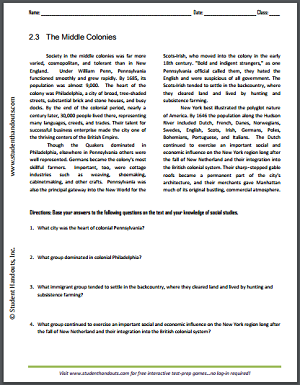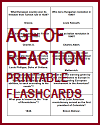
Society in the middle colonies was far
more varied, cosmopolitan, and tolerant than in New
England. Under William Penn, Pennsylvania functioned
smoothly and grew rapidly. By 1685, its population was
almost 9,000. The heart of the colony was Philadelphia, a
city of broad, tree-shaded streets, substantial brick and
stone houses, and busy docks. By the end of the colonial
period, nearly a century later, 30,000 people lived there,
representing many languages, creeds, and trades. Their
talent for successful business enterprise made the city one
of the thriving centers of the British Empire.
Though the Quakers dominated in
Philadelphia, elsewhere in Pennsylvania others were well
represented. Germans became the colony's most skillful
farmers. Important, too, were cottage industries such as
weaving, shoemaking, cabinetmaking, and other crafts.
Pennsylvania was also the principal gateway into the New
World for the Scots-Irish, who moved into the colony in the
early 18th century. "Bold and indigent strangers," as one
Pennsylvania official called them, they hated the English
and were suspicious of all government. The Scots-Irish
tended to settle in the backcountry, where they cleared land
and lived by hunting and subsistence farming.
New York best illustrated the polyglot
nature of America. By 1646, the population along the
Hudson River included Dutch, French, Danes, Norwegians,
Swedes, English, Scots, Irish, Germans, Poles, Bohemians,
Portuguese, and Italians. The Dutch continued to
exercise an important social and economic influence on the
New York region long after the fall of New Netherland and
their integration into the British colonial system.
Their sharp-stepped gable roofs became a permanent part of
the city's architecture, and their merchants gave Manhattan
much of its original bustling, commercial atmosphere.
 Society in the middle colonies was far
more varied, cosmopolitan, and tolerant than in New
England. Under William Penn, Pennsylvania functioned
smoothly and grew rapidly. By 1685, its population was
almost 9,000. The heart of the colony was Philadelphia, a
city of broad, tree-shaded streets, substantial brick and
stone houses, and busy docks. By the end of the colonial
period, nearly a century later, 30,000 people lived there,
representing many languages, creeds, and trades. Their
talent for successful business enterprise made the city one
of the thriving centers of the British Empire.
Society in the middle colonies was far
more varied, cosmopolitan, and tolerant than in New
England. Under William Penn, Pennsylvania functioned
smoothly and grew rapidly. By 1685, its population was
almost 9,000. The heart of the colony was Philadelphia, a
city of broad, tree-shaded streets, substantial brick and
stone houses, and busy docks. By the end of the colonial
period, nearly a century later, 30,000 people lived there,
representing many languages, creeds, and trades. Their
talent for successful business enterprise made the city one
of the thriving centers of the British Empire.










